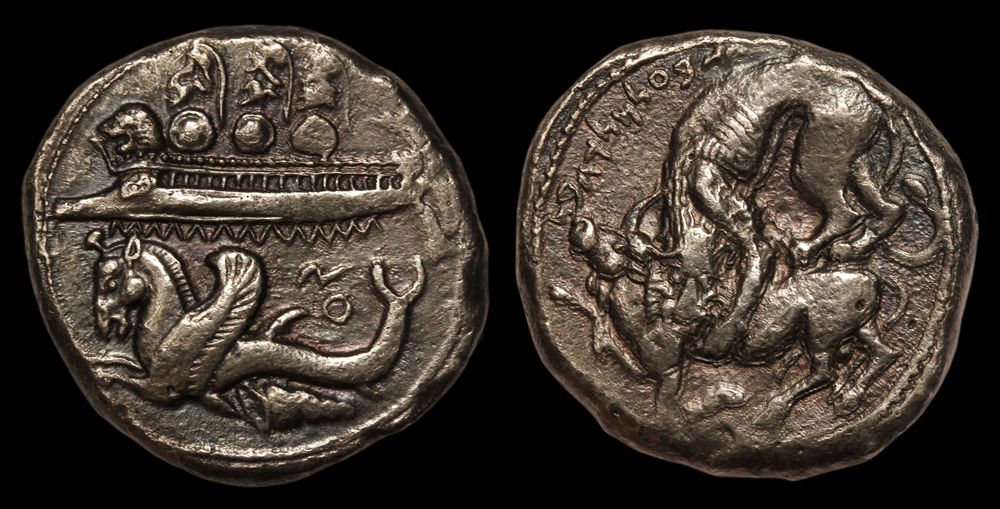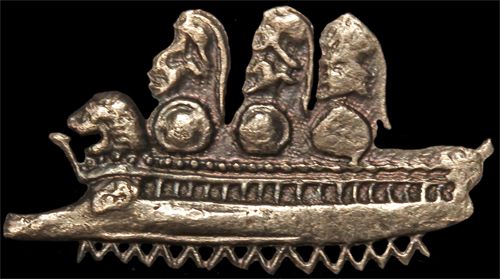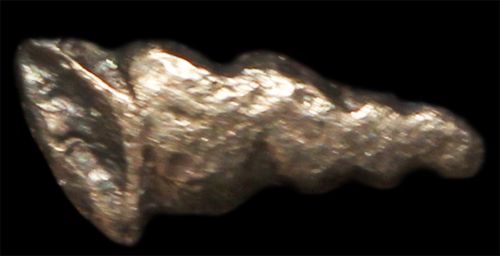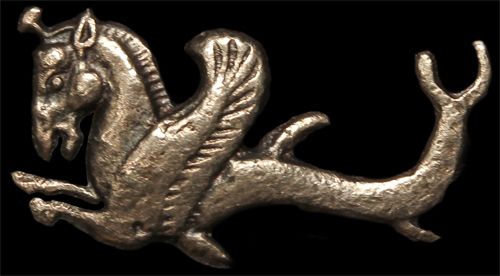Options
A coin from the Purple People

PHOENICIA, Byblos. Uzibaal. 350-335 BC*
AR dishekel, 13.3 gm
Obv: Three hoplites with shields in war galley left, roaring lion's head on prow, waves below galley; hippocamp left below; murex shell beneath; Z O (N O?) in field
Rev: Phoenician inscription*; lion attacking bull left
Ref: SNG Copenhagen 132, BMC 26.95, 4.
acquired August 2014
* Notes
- The date of this issue varies depending on source and ranges from 400 to 335 BC.
- Various references translate the inscription to ‘zb‘l mlk gbl (Ozbaal, king of Byblus).
Masters of the Sea

Positioned at the easternmost Mediterranean, Phoenicians capitalized on the waterways and were renowned for their seamanship. Keeled-hull ships allowed them to sail the open seas and as a result, Phoenicians developed a flourishing sea trade and unmatched naval power. You might consider them the world's first traveling salesmen.
Phoenician colonies extended to the Straits of Gibraltar. Some archaeologists believe they reached beyond Africa, even to the Americas.
Purple People

The murex shell represents Phoenicia’s namesake and prized product: purple dye. Manufactured from decomposed sea snails, the resulting purple dye is remarkably colorfast. Items dyed with Tyrian Purple in ancient times still retain their color today. Historical records indicate Phoenician purple dye was worth its weight in silver in some trading locales. Royal purple indeed; you’d have to be wealthy to afford a purple garment.
Mythologic tradition credits Herakles's dog with discovery. Per second century mythographer Julius Pollox, Herakles was strolling on the beach and noticed his dog chewing on a rotting murex snail. The dog’s mouth was stained vibrant purple. Rubens painted the scene but apparently he didn’t study marine biology. The sea snail in this painting is a nautilus, not a murex.
Who doesn't love a hippocamp?

The reason behind the appearance of a hippocamp on these coins is speculative. Perhaps to reinforce the “we rule the seas” message? Given the location and gentle appearance of the beast, I interpret it as protecting the ship and occupants… that the Phoenicians were on good terms with this mythical creature (and Poseidon). However, hippocamps and Poseidon were not part of traditional Phoenician religion and lore, or if they were, I haven’t found the sources. This coin was struck late in Phoenician history. Perhaps some Greek myths were woven into the Phoenician tapestry by then.
The ever-popular allegory

The reverse scene of a lion attacking a bull is similar to that found on many coins from many issuers. Is it merely a statement of power? An astronomical allusion? A specific threat? By the time of this coin’s striking, Phoenicia was divided into four vassal kingdoms of Persia. Was the coin a message to Macedon? Only mere decades later much of Phoenicia would fall to Alexander the Great.
If you are reading this, you can thank the Phoenicians

Our alphabet along with virtually all others have their origin in the Phoenician’s innovative 22-letter all-consonant alphabet. Even the word “alphabet” has a Phoenician origin: an elision of the first two letters, aleph and beth, which became alpha and beta —> alphabet.
Gebal (called Byblos by the Greeks) was a hub of this erudite activity as well as a papyrus producer. The English words book and bible stem from this city’s name.
While researching this coin I thought it would be fun to translate the reverse legend. Many hours later, I gave up. The Phoenician alphabet morphed over the centuries and I’m not sure of each character's identity. Even if I were, the next step of translating it to English is impossible for a linguistic novice. I did however learn that when researching coins, it is advisable to take a break now and then and to remember to eat. I failed to do so and by the end of the translation misadventure had become giddy and started playing with substitution cryptograms.
(In case you're curious, ONBOLMLWGBL solves to “BIG BEVERAGE”. Big Beverage. This coin was just a promotional token. Buy two vials of Tyrian Purple and get a free flagon of wine.)
Additional reading and fun links:
A Phoenician enthusiast's website
Traces of cocaine and tobacco found in Egyptian and Sudanese mummies Did Phoenicians travel to the Americas?
Evidence of Phoenician presence in Brazil?
Early history of sea warfare The Phoenicians kicked it up a dozen notches.
Assorted facts about Tyrian purple. No, it wasn't named after a Lannister.
..
Comments welcome, especially answers to the questions I failed to answer. Feel free to post any and all of your related coins!
0
Comments
World Collection
British Collection
German States Collection
<< <i>In case you're curious, ONBOLMLWGBL solves to “BIG BEVERAGE”. Big Beverage. This coin was just a promotional token. Buy two vials of Tyrian Purple and get a free flagon of wine.) >>
. Thanks for the great post!
Cathy
I'm sure it was alot of work, thank you.
We'll use our hands and hearts and if we must we'll use our heads.
Thanks for taking the time.
I love how all the devices are broken out with their own write up.
Inspiring.
great coin I've never seen before and a hell of a write up!
Taler Custom Set
Ancient Custom Set
Well done.
planetnumismatics.com/
I don't know how ONBOLMLWGBL translates to `zb`l mlk gbl, but assuming that this part is true, then the next phase has a striking similarity to Hebrew. MLK BBL is how you would write "King of Babylon" in Hebrew letters (mem-lamed-kaf bet-bet-lamed). Hebrew doesn't use vowel characters, so MLK BBL is read "Melech Babel". Melech is Hebrew for King, and Babel is Babylon. This is true for both present-day Hebrew and biblical Hebrew. I find that very interesting! (I'm assuming one of the G's is morphed into B somehow).
<< <i>That is absolutely fascinating.
I don't know how ONBOLMLWGBL translates to `zb`l mlk gbl, but assuming that this part is true, then the next phase has a striking similarity to Hebrew. MLK BBL is how you would write "King of Babylon" in Hebrew letters (mem-lamed-kaf bet-bet-lamed). Hebrew doesn't use vowel characters, so MLK BBL is read "Melech Babel". Melech is Hebrew for King, and Babel is Babylon. This is true for both present-day Hebrew and biblical Hebrew. I find that very interesting! (I'm assuming one of the G's is morphed into B somehow). >>
Thanks, that helps!
Actually, since writing this post I've come to understand the translation a bit better.
"o" ('ain) is a glottal consonant, represented in the numismatic literature with an apostrophe. Linguistic sources show a dotless question mark to indicate the sound.
What I thought was an "M" is apparently a "K" and "N" a "Z".
During my translation attempts I somehow forgot to use the Phoenician name for Byblos, Gebal.
With all of that in mind, ONBOL does translate to 'zb'l mlk gbl, or Uzbaal (insert whatever vowels float your boat-), King of Gebal.
found this Shekel in the archive of the Boston Museum:
Looks like the phoenician Hippocamp is a mix of the greek hippocamp without wings and Pegasus , the horse with wings.
Phoenicians did not invent the alphabet. They stole it from the Hebrews. All of the letters in your illustration, for example, are Hebrew letters. And yes even the names of the letters are the same. Lamed, mem, gimmel, nun ... "ain" (which is pronounced "eye" + "yunn" or "eye+yinn" depending on how long you lived in NYC :funny
The Hebrew alphabet is called aleph bet because of its first two letters ... hmm that little factoid sounds familiar doesn't it?
I don't fault you as many school books give credit to the Phoenicians. Of course, they also teach our children that Columbus discovered America.
edited to add: Take another look at desslok's post and you'll see more evidence to this fact. It's not just a coincidence. Same characters (as ancient Hebrew), same letter names, and even the same vocabulary.
Amat Colligendo Focum
Top 10 • FOR SALE
<< <i>You are very knowledgable, and I love reading your posts. But you've made an error ...
Phoenicians did not invent the alphabet. They stole it from the Hebrews. >>
I did come across conflicting information and the mostly unscholarly information I reviewed was all biased. People seem to have strong feelings about this issue. I was unable to sort out the facts, if indeed they are known.
Can you provide some good references supporting your assertion?
FOR SALE Items
<< <i>Phoenicians did not invent the alphabet. They stole it from the Hebrews. >>
I'm not sure this is historically correct. At least some sources say that the old Hebrew script descends from the Phoenician, not vice versa. This is also the view expressed in Wikipedia: http://en.wikipedia.org/wiki/Paleo-Hebrew_script
I'm not a historian (nor an ancient coin expert), but what intrigued me was that although the shape of the letters look nothing like what we use today, the names of the letters in the Phoenician coin, such as Nun, Bet, Lamed, Mem, are identical to letter names in present-day Hebrew. Also, at least one word - King - is written just like it would be in today's Hebrew.